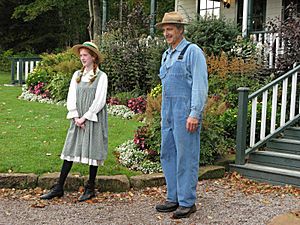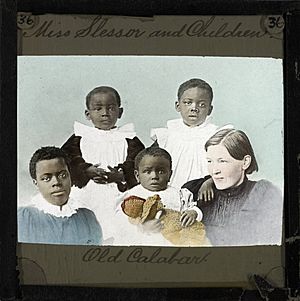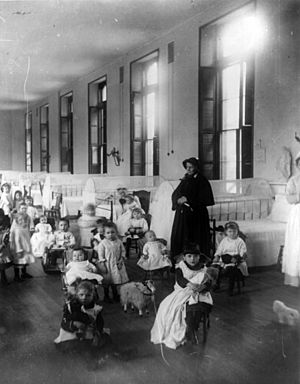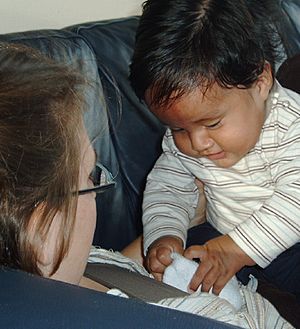Adoption facts for kids

Adoption is a legal way for a child to become a permanent member of a new family. It means a child gets new parents who are not their birth parents. When an adoption is final, the birth parents no longer have legal responsibilities for the child. Instead, the adoptive parents take on all those responsibilities and rights. Legally, an adopted child is just like a child born into the family.
Different places have different rules about adoption. Some have "closed" adoptions, where the adopted person and their birth parents don't have contact after the adoption. Others have "open" adoptions, which allow some contact.
In many countries, same-sex couples can also adopt children together.
Contents
Why do children get adopted?
Most children are placed for adoption because their birth parents decide they cannot properly care for them. Sometimes, birth parents lose their rights to care for a child if the child is not safe. A small number of children are adopted because their birth parents have passed away, making them orphans.
In the past, some children from certain groups, like Aboriginal Peoples in Australia or Native Americans in the United States and Canada, were placed with other families. This was a very difficult time for many of these children and their families.
Who helps with adoptions?
Adoption agencies help connect children with new families. These can be government groups that help for free or at a low cost. There are also private agencies and lawyers who arrange adoptions. The cost of adoption can vary greatly, from free to thousands of dollars.
Many adoptive parents hope to adopt babies or younger children. They often look for children of the same background as themselves.
How do adoptions happen?
Adoptions can happen within a family or between people who are not related. In the past, most adoptions were within families. Today, about half of adoptions in the U.S. are still within families. For example, a "step-parent adoption" happens when a parent's new partner legally adopts a child from a previous relationship.
Many parents choose to adopt children they are not related to because they cannot have children naturally. Studies show this is a common reason for adopting babies or children from foster care.
People adopt for many other reasons too. They might want to create a new family after a divorce or the death of a parent. Some are motivated by their beliefs to help children who need homes. Others might choose adoption to avoid passing on certain health conditions or due to health concerns about pregnancy.
Most women who adopt are typically between 40 and 44 years old, married, and have had difficulty having children naturally.
Here are some common ways adoptions happen:
- Private domestic adoptions: These happen when charities or private groups help connect hopeful adoptive parents with families who want to place a child. Everyone involved lives in the same country. A large number of adoptions in the United States are arranged this way.
- Foster care adoption: This is when a child is first placed in public care, often with foster parents. If the child cannot return to their birth family, the foster parents may choose to adopt them.
- International adoption: This involves adopting a child from a different country than your own. Both public and private agencies can help with international adoptions.
- Common law adoption: This is not a formal legal adoption. It happens when a parent leaves a child with a friend or relative for a long time without going through the courts.
Reuniting families
Many adopted people and birth parents who were separated by adoption wish to find each other again. In places with "closed" adoptions, people have worked to open sealed records. This helps adopted individuals access information about their birth families.
See also
Images for kids
-
At the monastery gate (Am Klostertor) by Ferdinand Georg Waldmüller
-
Josephine Baker adopted 10 children in the 1960s. In this photo they are on a tour of Amsterdam in 1964.
-
Children associated with'Hope and Homes for Children, a foster care program in Ukraine
 In Spanish: Adopción para niños
In Spanish: Adopción para niños










